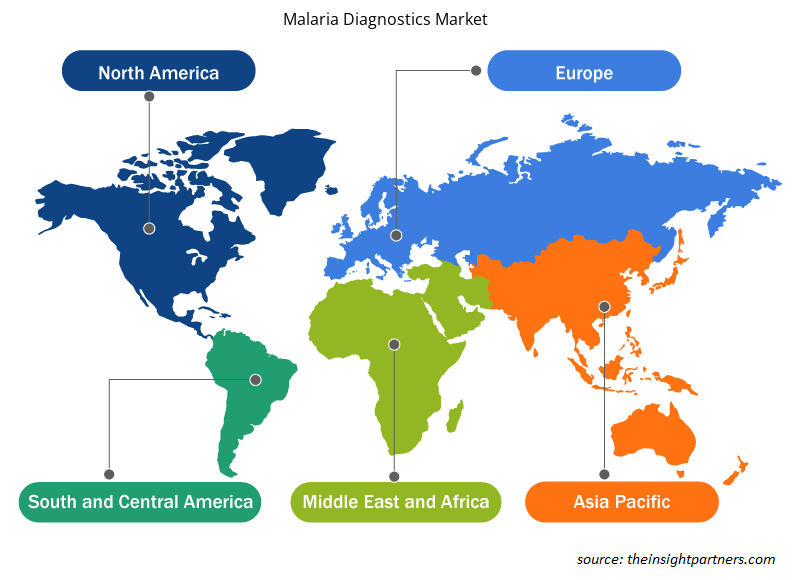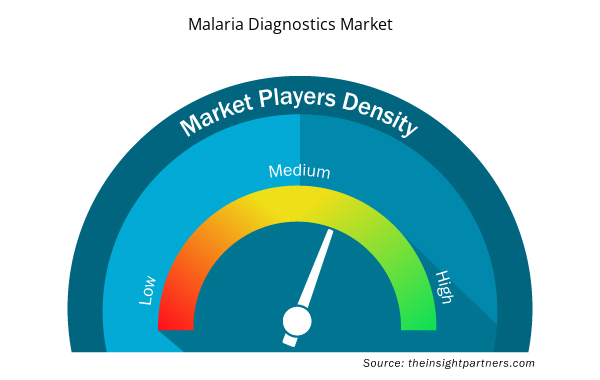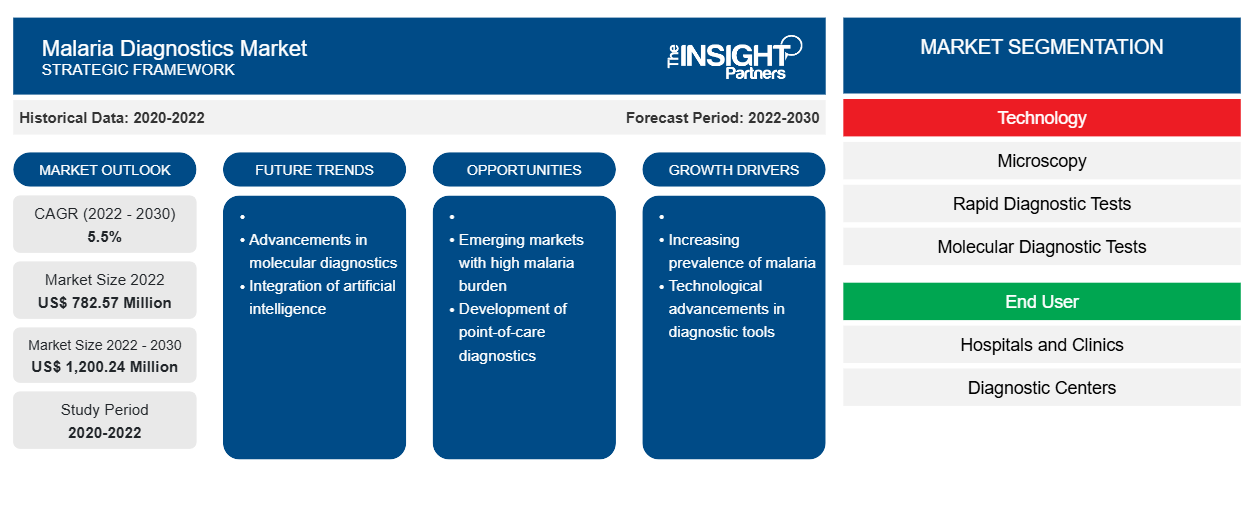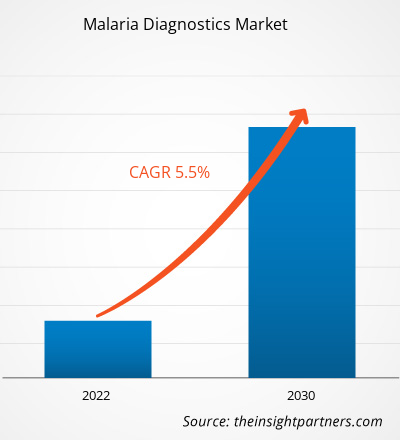[Forschungsbericht] Der Markt für Malariadiagnostik soll von 782,57 Millionen US-Dollar im Jahr 2022 auf 1.200,24 Millionen US-Dollar im Jahr 2030 wachsen; für den Zeitraum 2022–2030 wird eine durchschnittliche jährliche Wachstumsrate (CAGR) von 5,5 % erwartet.
Markteinblicke und Analystenansichten:
Malaria ist eine lebensbedrohliche Krankheit, die durch den Parasiten Plasmodium verursacht wird. Der Markt für Malariadiagnostik wächst aufgrund der hohen Malaria-Inzidenz in Ländern mit niedrigem Einkommen und der weltweit von internationalen und nationalen Organisationen umgesetzten Malaria-Eliminationsprogramme. Die zunehmende Einführung fortschrittlicher Diagnoseinstrumente und die zunehmende Forschungstätigkeit nach wirksamen Therapeutika tragen weiter zum Wachstum des Marktes bei.
Vor der COVID-19-Pandemie machte fast ein Drittel der endemischen Länder Fortschritte bei der Erreichung internationaler Ziele. Viele Länder mit geringer Malaria-Inzidenz waren Teil der „Elimination 2025 Initiative“ der WHO, einer Gruppe von 25 Ländern, die sich bemühen, Malaria bis 2025 potenziell auszurotten. In etwa einem Drittel der Länder hingegen stagnierte der Fortschritt, während in den anderen Ländern die Malaria-Inzidenz anstieg. Länder mit einer größeren Krankheitslast neigen eher dazu, Daten aus diagnostischen Tests zu verwenden, um geographisch geeignete Interventionen zu stratifizieren und zu fokussieren, ungeachtet der anhaltenden Bedeutung von Tests und Screenings bei Ausrottungsversuchen.
Aufgrund geringfügiger Störungen im Fallmanagement und bei Präventionsmaßnahmen nahmen die Malariafälle und -todesfälle im ersten Jahr der COVID-19-Epidemie zu. Dennoch konnte durch die Zusammenarbeit der WHO, nationaler Malariaprogramme und Partner ein mögliches Worst-Case-Szenario – eine Verdoppelung der Malariatodesfälle – vermieden werden. Schwierigkeiten bei der Beschaffung der notwendigen Malariavorräte und die Ungewissheit, wie sich die Pandemie letztlich auf die Malariabekämpfungsmaßnahmen auswirkte, waren ein Grund.
Wachstumstreiber:
Malaria, eine der akuten fiebrigen Erkrankungen, wird durch Plasmodium-Parasiten verursacht und durch infizierte weibliche Anopheles-Mücken übertragen. Fünf Parasitenarten verursachen beim Menschen hauptsächlich Malaria, und zwei dieser Arten – Plasmodium falciparum und P. vivax – gelten als die größte Bedrohung. Außerdem ist P. falciparum der tödlichste Malariaparasit und auf dem afrikanischen Kontinent am weitesten verbreitet. Darüber hinaus ist P. vivax in den meisten Ländern außerhalb Afrikas südlich der Sahara der vorherrschende Malariaparasit. Laut dem World Malaria Report (WMR) 2020 der Weltgesundheitsorganisation (WHO) wurden weltweit 241 Millionen Malariafälle gemeldet, verglichen mit 227 Millionen Fällen im Jahr 2019. Der gleichen Quelle zufolge steigt die Zahl der durch Malaria verursachten Todesfälle jährlich um 69.000. Ungefähr zwei Drittel dieser Todesfälle, d. h. 47.000, waren auf Störungen der Gesundheitsversorgung während der COVID-19-Pandemie zurückzuführen; das verbleibende Drittel der Todesfälle, d. h. 22.000, war auf eine kürzlich erfolgte Änderung der Methodik der WHO zur Berechnung der Malaria-Mortalität zurückzuführen (unabhängig von Störungen durch COVID-19).
Im Jahr 2020 wurden etwa 95 % der weltweiten Fälle und etwa 96 % der durch Malaria verursachten Todesfälle in der afrikanischen Region der WHO gemeldet, und etwa 80 % der insgesamt gemeldeten Todesfälle betrafen Kinder im Alter von 5 Jahren und darunter. Laut WMR 2021 wurden etwa 2 % der weltweiten Malarialast in südostasiatischen Ländern verzeichnet, wobei Indien im Jahr 2020 83 % der geschätzten Malariafälle und 82 % der mit der Krankheit verbundenen Todesfälle ausmachte. Somit fördert die steigende Prävalenz von Malaria in verschiedenen Regionen weltweit das Wachstum des Marktes für Malariadiagnostik.
Auf dem Markt ist eine begrenzte Anzahl von von der WHO vorab qualifizierten Produkten erhältlich, die keine PF-mRDTs sind. Trotz der Verfügbarkeit einer breiten Palette von von der WHO vorab qualifizierten mRDT-Produkten konzentriert sich die Nachfrage auf eine bevorzugte Untergruppe spezifischer Produkte und Hersteller. Dies schränkt die Fähigkeit des Marktes ein, Angebotsvielfalt, Sicherheit und Produktionskapazität zu gewährleisten. In diesem Zusammenhang stehen die Hersteller vor Herausforderungen wie einer geringen Produktnachfrage aus einigen Ländern sowie deren Zurückhaltung und mangelndem Interesse an der Einführung alternativer Produkte. Die Einführung alternativer Marken kann durch Änderungen der für die nationalen Algorithmen ausgewählten Marken oder durch Kostenauswirkungen ausgelöst werden.
Passen Sie diesen Bericht Ihren Anforderungen an
Sie erhalten kostenlos individuelle Anpassungen an jedem Bericht, einschließlich Teilen dieses Berichts oder einer Analyse auf Länderebene, eines Excel-Datenpakets sowie tolle Angebote und Rabatte für Start-ups und Universitäten.
- Holen Sie sich die wichtigsten Markttrends aus diesem Bericht.Dieses KOSTENLOSE Beispiel umfasst eine Datenanalyse von Markttrends bis hin zu Schätzungen und Prognosen.
Berichtssegmentierung und -umfang:
Der „Markt für Malariadiagnostik“ ist nach Technologie und Endnutzer segmentiert. Der Markt für Malariadiagnostik ist nach Technologie in Mikroskopie, Schnelldiagnosetests (RDTs) und molekulare Diagnosetests unterteilt. Das Segment der Schnelldiagnosetests (RDTs) hatte 2022 den größten Marktanteil und wird voraussichtlich zwischen 2022 und 2030 die höchste CAGR auf dem Markt verzeichnen. Der Markt für Malariadiagnostik ist nach Endnutzer in Krankenhäuser und Kliniken, Diagnosezentren und andere unterteilt. Das Segment Krankenhäuser und Kliniken hatte 2022 den größten Marktanteil. Das Segment Diagnosezentren wird voraussichtlich zwischen 2022 und 2030 die höchste CAGR auf dem Markt verzeichnen.
Segmentanalyse:
Der Markt für Malariadiagnostik ist nach Technologie in Mikroskopie, Schnelldiagnosetests (RDTs) und molekulardiagnostische Tests unterteilt.
Das Segment der Schnelldiagnosetests (RDTs) hatte 2022 den größten Marktanteil und wird voraussichtlich zwischen 2022 und 2030 die höchste durchschnittliche jährliche Wachstumsrate (CAGR) auf dem Markt verzeichnen. Durch den Nachweis des Vorhandenseins von Malariaparasiten im menschlichen Blut helfen Malaria-Schnelldiagnosetests (RDTs) bei der Diagnose von Malaria. RDTs bieten eine Alternative zur klinisch basierten Diagnose oder Mikroskopie, insbesondere in Situationen, in denen der Zugang zu hochwertigen Mikroskopiediensten eingeschränkt ist. Plasmodium falciparum oder P. vivax ist die einzige Art, die bestimmte RDTs identifizieren können, andere können jedoch vier Arten identifizieren: P. falciparum, P. vivax, P. malariae und P. ovale. Normalerweise wird zur Blutentnahme für den Test ein Fingerstich verwendet.
Der Markt für Malariadiagnostik ist nach Endverbraucher in Krankenhäuser und Kliniken, Diagnosezentren und andere unterteilt. Krankenhäuser und Kliniken entwickeln sich mit der steigenden Zahl von Patienten weltweit deutlich weiter. Sie bieten hochwirksame Behandlungen in kostengünstigen Umgebungen. Die zunehmende Betonung der Verwendung von RDTs aufgrund ihrer schnellen Durchlaufzeiten, niedrigen Kosten und bequemen Zugänglichkeit ist eine der Hauptursachen für die Dominanz von Kliniken auf dem Markt für Malariadiagnostik.
Regionale Analyse:
Der globale Markt für Malariadiagnostik ist geografisch in Nordamerika, Europa, Asien-Pazifik, Süd- und Mittelamerika sowie den Nahen Osten und Afrika unterteilt. Aufgrund wachsender Investitionen von Industrienationen wie den USA und den USA, größerer Patientenpopulationen und einer zunehmenden Betonung der Weltgesundheitsorganisation (WHO) auf der Senkung der Malaria-Sterberate in afrikanischen Ländern wird erwartet, dass die Region Naher Osten und Afrika im Prognosezeitraum ihre Marktdominanz beibehalten wird. Basierend auf den im Juli 2022 von der WHO veröffentlichten Daten ist es wahrscheinlich, dass etwa 95 % der Krankheitsfälle und 96 % der Todesfälle auf Subsahara-Afrika entfallen.
Regionale Einblicke in den Markt für Malariadiagnostik
Die regionalen Trends und Faktoren, die den Markt für Malariadiagnostik im Prognosezeitraum beeinflussen, wurden von den Analysten von Insight Partners ausführlich erläutert. In diesem Abschnitt werden auch die Marktsegmente und die Geografie der Malariadiagnostik in Nordamerika, Europa, im asiatisch-pazifischen Raum, im Nahen Osten und Afrika sowie in Süd- und Mittelamerika erörtert.

- Erhalten Sie regionale Daten zum Markt für Malariadiagnostik
Umfang des Marktberichts zur Malariadiagnostik
| Berichtsattribut | Details |
|---|---|
| Marktgröße im Jahr 2022 | 782,57 Millionen US-Dollar |
| Marktgröße bis 2030 | 1.200,24 Millionen US-Dollar |
| Globale CAGR (2022 - 2030) | 5,5 % |
| Historische Daten | 2020-2022 |
| Prognosezeitraum | 2022–2030 |
| Abgedeckte Segmente | Nach Technologie
|
| Abgedeckte Regionen und Länder | Nordamerika
|
| Marktführer und wichtige Unternehmensprofile |
|
Marktteilnehmerdichte im Bereich Malariadiagnostik: Auswirkungen auf die Geschäftsdynamik verstehen
Der Markt für Malariadiagnostik wächst rasant, angetrieben von der steigenden Nachfrage der Endnutzer aufgrund von Faktoren wie sich entwickelnden Verbraucherpräferenzen, technologischen Fortschritten und einem größeren Bewusstsein für die Vorteile des Produkts. Mit steigender Nachfrage erweitern Unternehmen ihr Angebot, entwickeln Innovationen, um die Bedürfnisse der Verbraucher zu erfüllen, und nutzen neue Trends, was das Marktwachstum weiter ankurbelt.
Die Marktteilnehmerdichte bezieht sich auf die Verteilung der Firmen oder Unternehmen, die in einem bestimmten Markt oder einer bestimmten Branche tätig sind. Sie gibt an, wie viele Wettbewerber (Marktteilnehmer) in einem bestimmten Marktraum im Verhältnis zu seiner Größe oder seinem gesamten Marktwert präsent sind.
Die wichtigsten auf dem Markt für Malariadiagnostik tätigen Unternehmen sind:
- Zugriff auf Bio., Inc.
- Abbott Laboratories
- Premier Medical Corporation Pvt. Ltd.
- Sysmex Partec GmbH
- bioMérieux
Haftungsausschluss : Die oben aufgeführten Unternehmen sind nicht in einer bestimmten Reihenfolge aufgeführt.

- Überblick über die wichtigsten Akteure auf dem Markt für Malariadiagnostik
Branchenentwicklungen und zukünftige Chancen:
Nachfolgend sind verschiedene strategische Entwicklungen führender Akteure auf dem Markt für Malariadiagnostik aufgeführt:
- Im Februar 2022 brachte das Kenya Medical Research Institute (KEMRI) Plasmochek für Malariatests auf den Markt. Plasmochek wurde entwickelt, um Plasmodium zu erkennen, einen Parasiten, der Malaria verursacht. Das Kit verwendet Antikörper, die spezifisch gegen Plasmodium falciparum Histidin-reiches Protein II und Plasmodium Lactat-Dehydrogenase gerichtet sind, um Malariainfektionen zu erkennen.
- Im Dezember 2019 entwickelten Access Bio und Global Good (ein Kooperationspartner des ersteren) einen neuen ultrasensitiven Schnelltest (uRDT), der bei der Identifizierung von Histidin-reichen Protein-2-Antigenen (HRP2) fünfmal sensitiver ist als derzeit verfügbare uRDTs. Darüber hinaus wurden verschiedene Tools zur Verbesserung der Malariadiagnose entwickelt.
Wettbewerbslandschaft und Schlüsselunternehmen:
Access Bio., Inc.; Abbott Laboratories; Premier Medical Corporation Pvt. Ltd.; Sysmex Partec GmbH; bioMerieux; Beckman Coulter Inc.; Siemens Healthineers; Leica Microsystems GmbH; Nikon Corporation; Olympus Corporation; und Bio-Rad Laboratories Inc. sind die führenden Unternehmen auf dem Markt für Malariadiagnostik. Diese Unternehmen konzentrieren sich auf neue Technologien, die Verbesserung bestehender Produkte und geografische Expansionen, um der wachsenden weltweiten Verbrauchernachfrage gerecht zu werden.
- Historische Analyse (2 Jahre), Basisjahr, Prognose (7 Jahre) mit CAGR
- PEST- und SWOT-Analyse
- Marktgröße Wert/Volumen – Global, Regional, Land
- Branche und Wettbewerbsumfeld
- Excel-Datensatz



Report Coverage
Revenue forecast, Company Analysis, Industry landscape, Growth factors, and Trends

Segment Covered
This text is related
to segments covered.

Regional Scope
North America, Europe, Asia Pacific, Middle East & Africa, South & Central America

Country Scope
This text is related
to country scope.
Häufig gestellte Fragen
Asia Pacific is expected to be the fastest growing region in the malaria diagnostics market. The growth of the market in Asia Pacific is anticipated to grow at a faster pace owing to factors such as growing need for superior treatment solutions, increasing focus on research and development activities. Additionally, India reported an 83.34% reduction in malaria morbidity and a 92% decrease in associated mortality during 2000–2019. The Centers for Disease Control and Prevention (CDC) claims that pregnant women are three times more susceptible to malaria infections as compared to others. Thus, rapid diagnosis and subsequent treatment plans are essential, which favor the growth of the malaria diadnostics market in India.
The malaria diagnostics market, based on end user, classified into hospitals and clinics, diagnostic centers, and others. The hospitals and clinics segment held the largest market share in 2022. The diagnostic centers segment is expected to register the highest CAGR in the market during 2022–2030.
The malaria diagnostics market, based on technology, is segmented into microscopy, rapid diagnostic tests (RDTs), and molecular diagnostic tests. The rapid diagnostic tests (RDTs) segment held the largest market share in 2022 and is estimated to register the highest CAGR in the market during 2022–2030.
Middle East and Africa holds the largest market share in malaria diagnostics market. Growing incidences of malaria is leading to increasing demand for malaria diagnostics. The market growth is owing to factors such as growing demand for rising awareness regarding malaria treatment and rising disposable income.
The factors that are driving growth of the market are increasing research and development activities and advancements in informatic solutions and imaging systems.
Malaria is a life-threatening disease caused by the plasmodium parasite. The malaria diagnostics market is growing due to the high incidence of malaria in low-income countries and globally implemented malaria elimination programs by international and national organizations. The increasing launches of advanced diagnostic tools and rising research activities for effective therapeutics are further contributing to the growth of the market.
The malaria diagnostics market majorly consists of the players such as Access Bio., Inc.; Abbott Laboratories; Premier Medical Corporation Pvt. Ltd.; Sysmex Partec GmbH; bioMerieux; Beckman Coulter Inc.; Siemens Healthineers; Leica Microsystems GmbH; Nikon Corporation; Olympus Corporation; and Bio-Rad Laboratories Inc. among others.
Trends and growth analysis reports related to Life Sciences : READ MORE..
The List of Companies - Malaria Diagnostics Market
- Access Bio., Inc.
- Abbott Laboratories
- Premier Medical Corporation Pvt. Ltd.
- Sysmex Partec GmbH
- bioMérieux
- Beckman Coulter, Inc.
- Siemens Healthineers
- Leica Microsystems GmbH
- Nikon Corporation
- Olympus Corporation
- Bio-Rad Laboratories, Inc.
The Insight Partners performs research in 4 major stages: Data Collection & Secondary Research, Primary Research, Data Analysis and Data Triangulation & Final Review.
- Data Collection and Secondary Research:
As a market research and consulting firm operating from a decade, we have published and advised several client across the globe. First step for any study will start with an assessment of currently available data and insights from existing reports. Further, historical and current market information is collected from Investor Presentations, Annual Reports, SEC Filings, etc., and other information related to company’s performance and market positioning are gathered from Paid Databases (Factiva, Hoovers, and Reuters) and various other publications available in public domain.
Several associations trade associates, technical forums, institutes, societies and organization are accessed to gain technical as well as market related insights through their publications such as research papers, blogs and press releases related to the studies are referred to get cues about the market. Further, white papers, journals, magazines, and other news articles published in last 3 years are scrutinized and analyzed to understand the current market trends.
- Primary Research:
The primarily interview analysis comprise of data obtained from industry participants interview and answers to survey questions gathered by in-house primary team.
For primary research, interviews are conducted with industry experts/CEOs/Marketing Managers/VPs/Subject Matter Experts from both demand and supply side to get a 360-degree view of the market. The primary team conducts several interviews based on the complexity of the markets to understand the various market trends and dynamics which makes research more credible and precise.
A typical research interview fulfils the following functions:
- Provides first-hand information on the market size, market trends, growth trends, competitive landscape, and outlook
- Validates and strengthens in-house secondary research findings
- Develops the analysis team’s expertise and market understanding
Primary research involves email interactions and telephone interviews for each market, category, segment, and sub-segment across geographies. The participants who typically take part in such a process include, but are not limited to:
- Industry participants: VPs, business development managers, market intelligence managers and national sales managers
- Outside experts: Valuation experts, research analysts and key opinion leaders specializing in the electronics and semiconductor industry.
Below is the breakup of our primary respondents by company, designation, and region:

Once we receive the confirmation from primary research sources or primary respondents, we finalize the base year market estimation and forecast the data as per the macroeconomic and microeconomic factors assessed during data collection.
- Data Analysis:
Once data is validated through both secondary as well as primary respondents, we finalize the market estimations by hypothesis formulation and factor analysis at regional and country level.
- Macro-Economic Factor Analysis:
We analyse macroeconomic indicators such the gross domestic product (GDP), increase in the demand for goods and services across industries, technological advancement, regional economic growth, governmental policies, the influence of COVID-19, PEST analysis, and other aspects. This analysis aids in setting benchmarks for various nations/regions and approximating market splits. Additionally, the general trend of the aforementioned components aid in determining the market's development possibilities.
- Country Level Data:
Various factors that are especially aligned to the country are taken into account to determine the market size for a certain area and country, including the presence of vendors, such as headquarters and offices, the country's GDP, demand patterns, and industry growth. To comprehend the market dynamics for the nation, a number of growth variables, inhibitors, application areas, and current market trends are researched. The aforementioned elements aid in determining the country's overall market's growth potential.
- Company Profile:
The “Table of Contents” is formulated by listing and analyzing more than 25 - 30 companies operating in the market ecosystem across geographies. However, we profile only 10 companies as a standard practice in our syndicate reports. These 10 companies comprise leading, emerging, and regional players. Nonetheless, our analysis is not restricted to the 10 listed companies, we also analyze other companies present in the market to develop a holistic view and understand the prevailing trends. The “Company Profiles” section in the report covers key facts, business description, products & services, financial information, SWOT analysis, and key developments. The financial information presented is extracted from the annual reports and official documents of the publicly listed companies. Upon collecting the information for the sections of respective companies, we verify them via various primary sources and then compile the data in respective company profiles. The company level information helps us in deriving the base number as well as in forecasting the market size.
- Developing Base Number:
Aggregation of sales statistics (2020-2022) and macro-economic factor, and other secondary and primary research insights are utilized to arrive at base number and related market shares for 2022. The data gaps are identified in this step and relevant market data is analyzed, collected from paid primary interviews or databases. On finalizing the base year market size, forecasts are developed on the basis of macro-economic, industry and market growth factors and company level analysis.
- Data Triangulation and Final Review:
The market findings and base year market size calculations are validated from supply as well as demand side. Demand side validations are based on macro-economic factor analysis and benchmarks for respective regions and countries. In case of supply side validations, revenues of major companies are estimated (in case not available) based on industry benchmark, approximate number of employees, product portfolio, and primary interviews revenues are gathered. Further revenue from target product/service segment is assessed to avoid overshooting of market statistics. In case of heavy deviations between supply and demand side values, all thes steps are repeated to achieve synchronization.
We follow an iterative model, wherein we share our research findings with Subject Matter Experts (SME’s) and Key Opinion Leaders (KOLs) until consensus view of the market is not formulated – this model negates any drastic deviation in the opinions of experts. Only validated and universally acceptable research findings are quoted in our reports.
We have important check points that we use to validate our research findings – which we call – data triangulation, where we validate the information, we generate from secondary sources with primary interviews and then we re-validate with our internal data bases and Subject matter experts. This comprehensive model enables us to deliver high quality, reliable data in shortest possible time.


 Holen Sie sich ein kostenloses Muster für diesen Bericht
Holen Sie sich ein kostenloses Muster für diesen Bericht